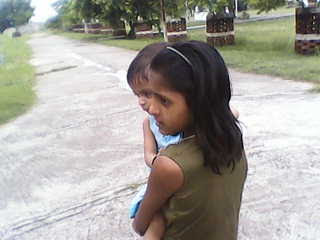a public sevant in a uttar pradesh office committing multiple crime.
1- keeping her baby with her during duty hours
2- employing a child to take care of her baby thus ruing the career of
that girl child
3- taking salary from government coffers to do her personal work at workplace
4- making the workplace a place of household chores
sending pics also
urvashi
Child Labour is a Crime
IPC section 374
According to this section that whoever unlawfully compels any person
to labour against the will of that person, shall be punished with
imprisonment of either description for a term which may extend to one
year or with fine or both.
The Child Labour (Prohibition & Regulation) Act, 1986
The act prohibits the employment of children below the age of 14 in
factories, mines and in other forms of hazardous employment (including
domestic labour and service industry), and regulates the working
conditions of children in other employment.
Government servants are prohibited from employing children as domestic
servants. Through the recent notification effective from 10 October
2006, the government has imposed these restrictions on everyone.
Juvenile Justice (Care and Protection of Children) Act, 2000
Under this act any person responsible for abuse assault and neglect or
causing physical or mental suffering can be punished for up to 6
months and/or fined.
Also any person who procure a juvenile or the child for hazardous
work, keeps him in bondage and withholds the child's earnings or uses
them for his own purpose is liable for imprisonment up to 3 years and
also a fine.
Bonded Labour System (Abolition) Act, 1976
Under this act any kind of forced labour including child labour is a
punishable offence. There are many incidences where judiciary has
acted for elimination of child labour and has dealt with it as forced
labour or bonded labour.
Supreme Court Directions on Child Labour
The Supreme Court of India, 1996 has given certain directions
regarding the manner in which children working in the hazardous
occupations are to be withdrawn from work and rehabilitated, and the
manner in which the working conditions of children working in
non-hazardous occupations are to be regulated and improved.
The judgment of the Supreme Court envisages:
• Withdrawal of children working in hazardous industries and ensuring
their education in appropriate institutions;
• Contribution of Rs.20,000 per child to be paid by the offending
employers of children to a welfare fund to be established for this
purpose;
• Employment to one adult member of the family of the child so
withdrawn from work, and if that is not possible a contribution of
Rs.5000 to the welfare fund to be made by the State Government;
• Financial assistance to the families of the children so withdrawn to
be paid out of the interest earnings on the corpus of Rs. 20,000 or
Rs. 25,000 deposited in the welfare fund as long as the child is
actually sent to the schools
In a nutshell, the recent notification regarding child labour simply
means that any body employing children of 14 years of age, can be
prosecuted as a criminal. It also means that government is accountable
to deal with child domestic labour as a crime, and should make all
efforts for its control and elimination. It should also make
arrangements to provide justice, compensation and rehabilitation to
the victim
Saturday, 18 August 2012
Subscribe to:
Post Comments (Atom)





No comments:
Post a Comment